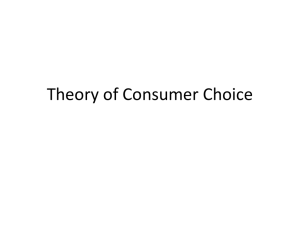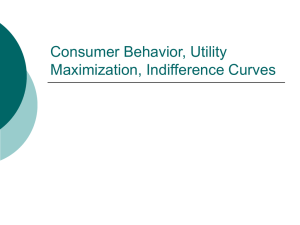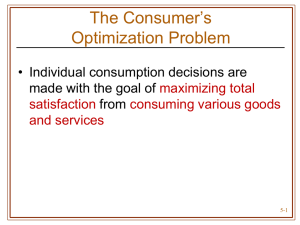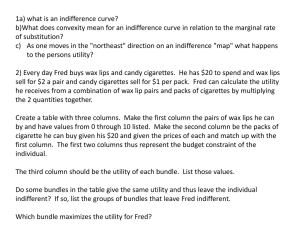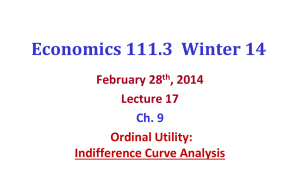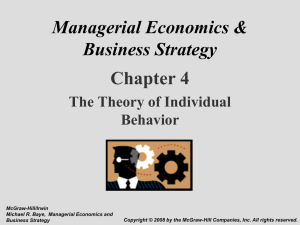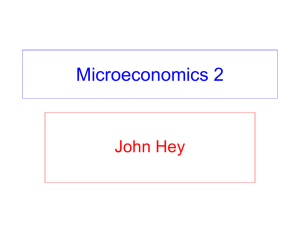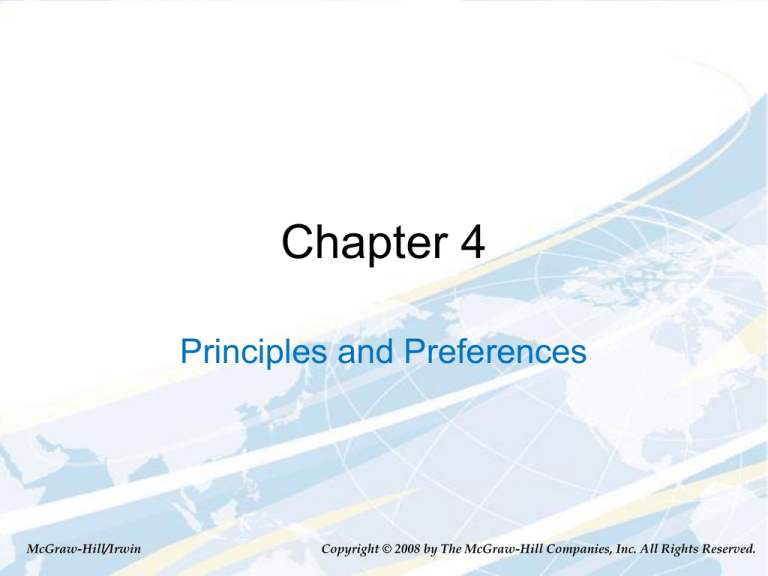
Chapter 4
Principles and Preferences
McGraw-Hill/Irwin
Copyright © 2008 by The McGraw-Hill Companies, Inc. All Rights Reserved.
Last Chapter Review
During the last chapter, we looked at the
basic concepts concerning…
Maximizing benefits less costs
Thinking on the margin
Marginal Benefit vs. Cost
Sunk costs and decision-making
3-2
Main Topics
Today’s class is the beginning of material that
may be new to you. This, and the next 10
chapters involve the principles of economic
decision making.
Today will deal with decisions by consumers
concerning the goods they purchase.
Topics covered:
Principles of decision-making
Consumer preferences
Substitution between goods
Utility
4-3
Building Blocks of Consumer
Theory
To start our class, we will first
contemplate the food in front of us….
Peperos
Chips
Coke
Which products are the “best”?
Which of these products do you like best?
Worst? Equally well?
How much of each would you like me to
give you?
4-4
Building Blocks of Consumer
Theory
Preferences tell us about a consumer’s likes
and dislikes due to personal, emotional or
intangible reasons.
A consumer is indifferent between two
alternatives if she likes (or dislikes) them
equally
Assumptions of consumer behavior…
The Ranking Principle: A consumer can rank, in
order of preference, all potentially available
alternatives (ties are also possible)
The Choice Principle: Among available alternatives,
the consumer chooses the one that he ranks the
highest
4-5
The Consumer’s Problem
A consumer’s economic problem is to allocated
limited funds to competing needs and desires
over some time period
Chooses a consumption bundle
The collection of goods that an individual consumes
over a given period (hour/day/month/etc)
Should reflect preferences over various
bundles, not just feelings about any one good
in isolation
Decision to consume more of one good is a
decision to consume less of another
4-6
Principles of Consumer DecisionMaking
The Ranking Principle: A consumer can rank,
in order of preference, all potentially available
alternatives
The Choice Principle: Among available
alternatives, the consumer chooses the one
that he ranks the highest
The More-is-better Principle: When one
consumption bundle contains more of every
good than a second bundle, a consumer
prefers the first bundle to the second
4-7
Principles of Consumer DecisionMaking
Madeline likes to
eat at a
restaurant that
only serves
bread and water.
Which bundle is
her first
choice…second
…last? Why?
4-8
Principles of Consumer DecisionMaking
What about your preferences between
pepero and chips?
How would you build a table similar to
that of soup/bread?
Are there any combinations that you like
equally?
4-9
Indifference Curves
Use when goods are (or assumed to be)
available in any fraction of a unit
Represent alternatives graphically or
mathematically rather than in a table
Starting with any alternative, an
indifference curve shows all the other
alternatives a consumer likes equally well
4-10
Figure 4.1: Identifying Alternatives
and Indifference Curves
Which points
are liked
equally as
much as A?
Which are
not as good?
Which are
better?
WHY?
4-11
Properties of Indifference Curves
Thin
Do not slope upward
Separates bundles that are better from bundles
that are worse than those that are on the
indifference curve
Why?
Think
about
the More
is Better
Principle
4-12
Families of Indifference Curves
Collection of indifference curves that
represent the preferences of an individual
Do not cross
Comparing two bundles, the consumer
prefers the one on the indifference curve
further from the origin
4-13
Figure 4.3: A Family of
Indifference Curves
4-14
Figure 4.4: Indifference Curves
Do Not Cross
4-15
Properties of Indifference Curves
To reiterate….there are 5 properties of
indifference curves.
Thin
Do not slope upward
Separates bundles that are better from
bundles that are worse than those that are
on the indifference curve
Indif. curves from the same family do not
cross
Comparing any two bundles, the consumer
prefers the one on the indifference curve
further from the origin
4-16
Formulas for Indifference Curves
More complete and precise to describe
preferences mathematically
For example, can write a formula for a
consumer’s indifference curves
Formula describes an entire family of
indifference curves
Each indifference curve represents a particular
level of well-being
Higher levels of well-being are on indifference
curves further from the origin
4-17
Figure 4.6: Plotting Indifference
Curves
Formula for
indifference curves is
B = U/S
U is well-being, or
“utility” (more later in
lecture)
To find a particular
curve, plug in a value
for U, then plot the
relationship between
B and S
4-18
Indifference Curves - Practice
See p104, In-Text Exercise.
Julie likes Coke and Pepsi.
Indifference curve formula is C=U-1.2P
Draw some of the indif. Curves.
Which bundle does she prefer
1 liter of Coke and no Pepsi
Or 1 liter of Pepsi and no Coke?
4-19
Indifference Curves - Practice
See p104, In-Text Exercise.
Solve for U, thereby making a utility function.
Before C=U-1.2P so now U = C + 1.2P
Now, we can plug the two bundles into the utility
function to compare them.
U(C, P) = C + 1.2P
U(1, 0) = 1 + 1.2(0) = 1
U(0, 1) = 0 + 1.2(1) = 1.2
Since the bundle consisting of
one liter of Pepsi and no Coke
provides the greater level of utility,
Judy prefers this bundle.
Judy gets more “value” or utility
from Pepsi than Coke. Hence 6
Cokes = 5 Pepsis
4-20
Goods and Bads
A bad is an object, condition or activity
that makes a consumer worse off.
Here are 2 different indiv. curve sets.
Which contains a bad?
4-21
Substitution Between Goods
Economic decisions involve trade-offs
To determine whether a consumer has
made the best choice, we need to know
the rate at which she is willing to make
trade-offs between different goods
Indifference curves provide that
information
4-22
Rates of Substitution
Consider moving along an indifference curve,
from one bundle to another
This is the same as subtracting units of one
good and compensating the consumer for the
loss by adding units of another good
Slope of the indifference curve shows how
much of the second good is needed to make
up for the decrease in the first good
4-23
Figure 4.8: Rates of Substitution
Look at move from
bundle A to C
Consumer loses 1
soup; gains 2 bread
Willing to substitute
for soup with bread
at 2 ounces per pint
4-24
Marginal Rate of Substitution
The marginal rate of substitution for X with Y,
MRSXY, is the rate at which a consumer must
adjust Y to maintain the same level of wellbeing when X changes by a tiny amount, from a
given starting point
MRSXY Y X
Tells us how much Y a consumer needs to
compensate for losing a little bit of X
Tells us how much Y to take away to
compensate for gaining a little bit of X
4-25
Figure 4.9: Marginal Rate of
Substitution
Marginal Rate of
Substitution for soup
with bread at bundle
A
MRSSB=-B/S=-3/2
or -1.5 ounces of
bread for 1 pint of
soup
What about the MRS
for bread with soup?
4-26
What Determines Rates of
Substitution?
Differences in tastes
Preferences for one good over another affect the
slope of an indifference curve
Implications for MRS
Starting point on the indifference curve
People like variety so most indifference curves get
flatter as we move from top left to bottom right
Link between slope and MRS implies that MRS
declines; the amount of Y required to compensate
for a given change in X decreases
4-27
Figure 4.10: Indifference Curves
and Consumer Tastes
4-28
Figure 4.11: MRS along an
Indifference Curve
Demonstrates that
people like variety.
We will say than an
indif. curve has a
declining MRS if it
becomes flatter as
we move along the
curve from the NW
to the SE
4-29
Formulas for MRS
MRS formula tells us the rate at which a
consumer will exchange one good for
another, given the amounts consumed
Every indifference curve formula has an
MRS formula that describes the same
preferences
Indifference curves: B=U/S; MRSSB=B/S
4-30
Importance of MRS
Assists in determining whether different
people will trade.
If trade will result in a mutually beneficial
situation, people will make the exchange.
This mutually beneficial situation is
determined by the peoples’ MRS.
4-31
In-Text Exercise 4.3
Kate (M&M) and Antonio (MD) swapped
8 M&Ms for 5 Milk Duds
What is the MRS for each party?
If each person believed that 2 M&Ms = 1
Milk Dud, would they still have made the
trade?
4-32
In-Text Exercise 4.3
Since Kate gave up eight M&Ms for five Milk Duds, we know that she
values Milk Duds more than M&Ms. Her MRS for Milk Duds with M&Ms
must be greater or equal to 1.6 (M&Ms / Milk Duds = 8 / 5 = 1.6). This
means that Kate believes that one Milk Dud is a perfect substitute for at
least 1.6 M&Ms. For example, if she believed that one Milk Dud was
worth 2 M&Ms she would have still made this trade, because she’s giving
up less than she would be willing to. On the other hand, if she believed
one Milk Dud was worth fewer than 1.6 M&Ms, say 1.5, then she would
not make this trade because she would be paying more for Milk Duds
than she is willing to.
Since Antonio willingly gave up five Milk Duds for eight M&Ms, he
probably believes that eight M&Ms have a greater value than five Milk
Duds or, equivalently, he probably believes that 1.6 M&Ms have a greater
value than one Milk Dud. Therefore, Antonio’s MRS for Milk Duds with
M&Ms is at most 1.6, but it is most likely less. If his MRS were equal to 1,
so that he thought one M&M was the same as one Milk Dud, then he
would definitely make this trade with Kate. However, if his MRS were
greater than 1.6, say 2, so that he believed that it took two M&Ms to equal
one Milk Dud, then Antonio would not accept only eight M&Ms for his five
Milk Duds; he would require ten.
In summary, Kate’s MRS>= 1.6 while Antonio’s MRS<= 1.6.
4-33
Perfect Substitutes and
Complements
Some special cases of preferences represent
opposites ends of the substitutability spectrum
Two products are perfect substitutes if their
functions are identical; a consumer is willing to
swap one for the other at a fixed rate
Two products are perfect complements if they
are valuable only when used together in fixed
proportions
Note that the goods do not have to be
exchanged one-for-one!
Examples?
4-34
Figure 4.12: Perfect Substitutes
4-35
Figure 4.13: Perfect Complements
4-36
Neutrals
Goods are neutral
goods if the
consumer doesn’t
care about it.
Ie. Pepperoni and
sausage on our
pizza. I only care
about the amount of
sausage. Don’t care
about the pepperoni.
Bads
A bad is an object, condition or activity
that makes a consumer worse off.
4-38
Utility
Summarizes everything that is known about
a consumer’s preferences
Utility is a numeric value indicating the
consumer’s relative well-being
Recall that the consumer’s goal is to benefit
from the goods and services she uses
Can describe the value a consumer gets
from consumption bundles mathematically
through a utility function which assigns a
utility value to each consumption bundle.
U S , B 2S 5S B
4-39
Utility Functions and Indif. Curves
Utility functions must assign the same value to
all bundles on the same indifference curve
Must also give higher utility values to
indifference curves further from the origin
Can start with information about preferences
and derive a utility function
Or can begin with a utility function and
construct indifference curves
Can also think of indifference curves as
“contour lines” for different levels of utility
4-40
Figure 4.14: Representing
Preferences with a Utility Function
4-41
Deriving Indifference Curves from
a Utility Function
For each bundle, the
utility corresponds to
the height of the
utility “hill”
The indifference
curve through A
consists of all
bundles for which the
height of the curve is
the same
4-42
Ordinal vs. Cardinal Utility
Information about preferences can be ordinal
or cardinal
Ordinal information allows us to determine
only whether one alternative is better than
another
Cardinal information reveals the intensity of
preferences, “How much worse or better?”
Difficulty in measuring this kind of utility
Utility functions are intended to summarize
ordinal information
Scale of utility functions is arbitrary; changing
scale does not change the underlying
preferences
4-43
Marginal Utility
To make a link between MRS and utility,
need a new concept
Marginal utility is the change in a
consumer’s utility resulting from the addition
of a very small amount of some good, divided
by the amount added
MU X U X
4-44
Utility Functions and MRS
MRS XY
MU X
MU Y
Small change in X, X, causes utility to
change by MUXX
Small change in Y, Y, causes utility to
change by MUYY
If we stay on same indifference curve,
then –Y/X =MUX/MUY
4-45
Summary
Principles of Decision Making
Ranking / Choice Principles
Consumer Preferences
Need to compare Consumption Bundles
Consumers prefer more to less
Indif. curves are thin and never slope up
I.C. that runs through a bundle separates all
better alternatives from all other options.
I.C. from the same family never cross.
For every bad, there is an assoc. good.
4-46
Summary
Substitution between goods
MRS varies from one consumer to another
according to the relative importance the
consumer attaches to the goods in question.
MRS for X with Y declines as X becomes
more plentiful and Y more scarce.
Whether people trade depends upon their
MRS
I.C. for perfect substitutes is a straight line
and L-shaped for complements
4-47
Summary
Utility
Summarizes everything that is known about
a consumer’s preferences
Can create a utility function from a family of
I.C. by assigning the same utility value to all
bundles on the same curve. Higher value
curves correspond to higher levels of wellbeing.
Utility usually used to for ordinal (not
cardinal) information
By itself, marginal utility doesn’t measure
anything meaningful. The ratio though is
equal to equiv. MRS
4-48
Problems
1. Binch Cookies vs. Chips
What is your MRS between the two?
2. After reading this chapter, a student
complains, “What I like and dislike isn't
always the same; it depends on my
mood.” Is this a problem with consumer
preference theory? Why or why not?
4-49
Problems
2. After reading this chapter, a student
complains, “What I like and dislike isn’t
always the same; it depends on my
mood.” Is this a problem with consumer
preference theory? Why or why not?
No. This is not a problem with consumer
preference theory. Consumer preference
theory does not require that preferences
never change (such as with mood). What it
does require is that, at any given time, a
consumer can rank all possible alternatives
(though possibly with ties).
4-50

